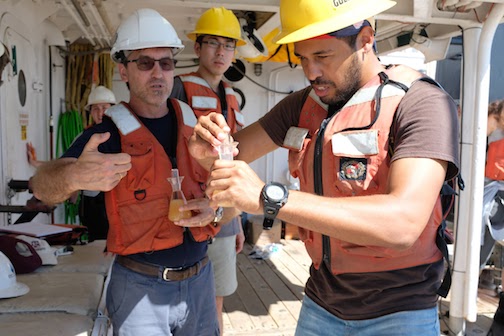Heavy rainfall during Hurricane Harvey flushed most of the salt water out of Galveston Bay, making the bay extremely fresh. Now, researchers from Texas A&M University are working to collect vital information on how the storm impacted the waterways of coastal Texas.
Dr. Scott Socolofsky, professor in the Zachry Department of Civil Engineering, joined principal investigator Dr. Kristen Thyng and other researchers from Texas A&M’s Department of Oceanography to study how Galveston Bay and the coastal Gulf of Mexico responded to the extreme amount of freshwater that poured into the gulf from rainfall and runoff from the Houston area.
“Normally, tidal exchange between the bay and the Gulf of Mexico keep the bay fairly salty,” Socolofsky said. “By studying the rates that salt water re-enters the bay and the exchange processes of salty and fresh water at the bay inlet, we can better understand the normal mixing patterns between Galveston Bay and the Gulf of Mexico.”
Texas A&M Examines Effects Of Floodwater On Flower Garden Banks Marine Sanctuary
By recording these salt water rates, scientists can better understand the water exchange rate between the bay and open coast and supply the measurements for use in future models to help study Harvey and similar events.
The project is funded through a Rapid Response Research (RAPID) grant from the National Science Foundation (NSF). RAPID grants focus on projects with severe urgency with regard to availability of, or access to, data, facilities or specialized equipment, including quick-response research on natural disasters. The researchers are expected to turn in their results to the NSF within the first year of being awarded the grant.
With eyes on Galveston Bay, the team conducted its first cruise offshore from Sept. 27-29 using the Point Sur, a research vessel from the Division of Marine Science at the University of Southern Mississippi. The research team mapped the freshwater flowing out of Galveston Bay in the immediate vicinity of the Galveston Bay Inlet on the Gulf of Mexico side of Galveston and Boliver Island.
This cruise was the second leg of a three-leg cruise, in which three different RAPID grants to oceanography faculty collaborated to form a complete cruise plan. Socolofsky was co-PI and his team included civil engineering graduate Kerri Whilden, who works for the Texas A&M Geochemical & Environmental Research Group.
Another cruise conducted on Oct. 8 mapped the salinity distribution in the bay, and Socolofsky said results found the water to be much fresher compared to normal conditions.
Two more offshore cruises are scheduled in November and February with two more bay-wide surveys.
###
This story by Jennifer Reiley originally appeared on the College of Engineering website.





